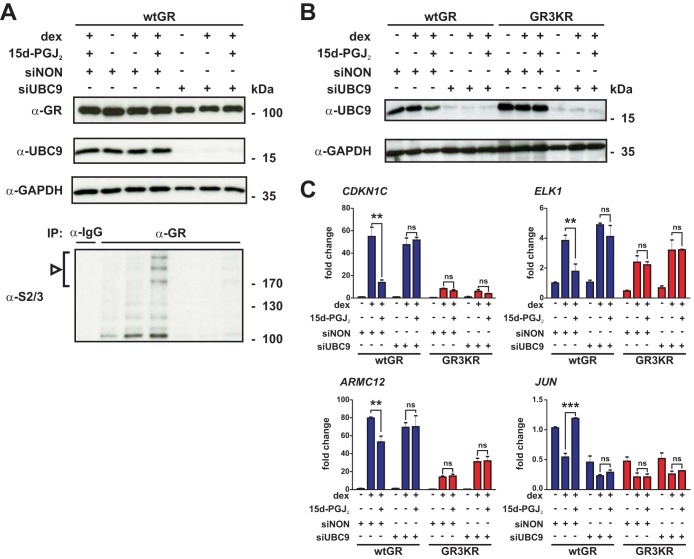FIG 3.
SUMOylation modulates the inhibition of GR by 15d-PGJ2. HEK293 cells stably expressing wtGR- and GR3KR were transfected with 40 nM Dharmacon On-TARGETplus SMARTpool for human UBE2I (siUBC9) or Non-Targeting pool (siNON) by Lipofectamine RNAiMAX. After 96 h, the cells in the experiment represented in panel A were treated with vehicle, with dex, or with dex in the presence of 15d-PGJ2 as described in the Fig. 2B legend and the cells in the experiments represented in panels B and C were treated as described in the Fig. 1A legend with 5 μM 15d-PGJ2, and RNA and proteins were isolated. (A) Cells were lysed in a denaturing buffer, and portions of lysates (20% of the immunoprecipitation inputs) were analyzed by immunoblotting with anti-UBC9, anti-GR, and anti-GAPDH antibodies or were subjected to immunoprecipitation with anti-GR antibody and subsequent immunoblotting with anti-SUMO-2/3 (S2/3) antibody. The arrowhead and bracket indicate the position of SUMO-2/3-modified forms of GR. (B) Proteins were analyzed by immunoblotting with anti-UBC9 and anti-GAPDH antibodies. (C) RT-qPCR analyses were performed with specific primers for CDKN1C, ELK1, ARMC12, and JUN. Results represent the means ± SD of the results of three experiments. ***, P < 0.001; **, P < 0.01 (for the differences in the results of dex treatment in the presence or absence of 15d-PGJ2 [Student's t test]). ns, no significance.

